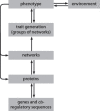Modelling speciation: Problems and implications
- PMID: 36502315
- PMCID: PMC10741375
- DOI: 10.3233/ISB-220253
Modelling speciation: Problems and implications
Abstract
Darwin's and Wallace's 1859 explanation that novel speciation resulted from natural variants that had been subjected to selection was refined over the next 150 years as genetic inheritance and the importance of mutation-induced change were discovered, the quantitative theory of evolutionary population genetics was produced, the speed of genetic change in small populations became apparent and the ramifications of the DNA revolution became clear. This paper first discusses the modern view of speciation in its historical context. It then uses systems-biology approaches to consider the many complex processes that underpin the production of a new species; these extend in scale from genes to populations with the processes of variation, selection and speciation being affected by factors that range from mutation to climate change. Here, events at a particular scale level (e.g. protein network activity) are activated by the output of the level immediately below (i.e. gene expression) and generate a new output that activates the layer above (e.g. embryological development), with this change often being modulated by feedback from higher and lower levels. The analysis shows that activity at each level in the evolution of a new species is marked by stochastic activity, with mutation of course being the key step for variation. The paper examines events at each of these scale levels and particularly considers how the pathway by which mutation leads to phenotypic variants and the wide range of factors that drive selection can be investigated computationally. It concludes that, such is the complexity of speciation, most steps in the process are currently difficult to model and that predictions about future speciation will, apart from a few special cases, be hard to make. The corollary is that opportunities for novel variants to form are maximised.
Keywords: Evolution; selection; speciation; systems biology; variation (phenotypic).
Figures






References
-
- Coyne J.A., Orr H.A., Speciation. Sinauer Press, Oxford, 2004.
-
- Gould S.J. A Tree Grows in Paris: Lamarck’s Division of Worms and Revision of Nature, In: The Lying Stones of Marrakech: Penultimate Reflections in Natural History, Harmony Books, 2000, pp. 115–143.
-
- Gehring W.J., The evolution of vision, Wiley Interdiscip Rev Dev Biol 3 (2014), 1–40. - PubMed
-
- Kemp T. The Origin of Higher Taxa: Palaeobiological, Developmental, and Ecological Perspectives, University of Chicago Press, 2015.
MeSH terms
LinkOut - more resources
Full Text Sources
Medical

